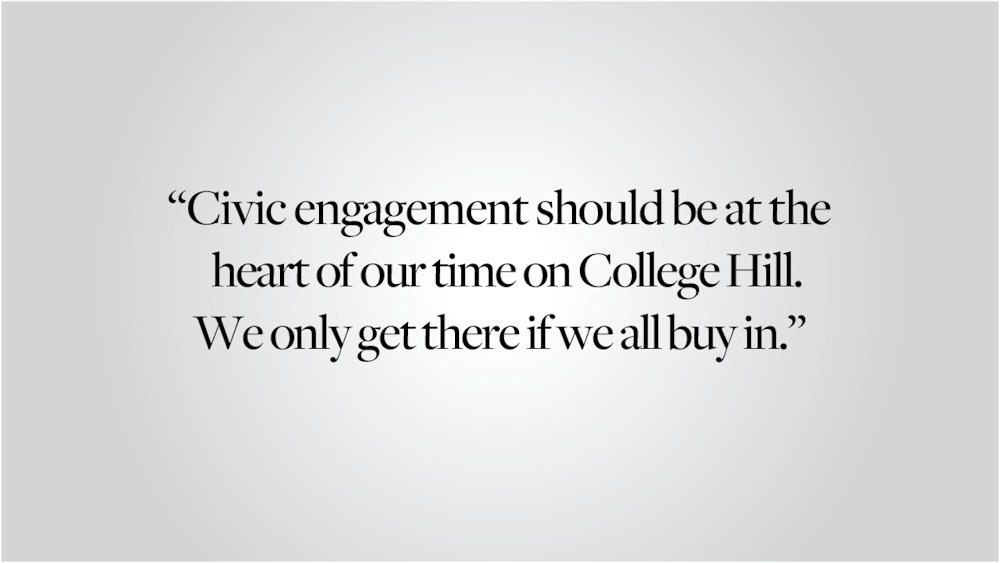Brown students pride themselves on being politically minded. As a school, we’ve had a long history of protest over the decades, continuing to the present day. However, those feelings don’t necessarily translate into voter turnout. In 2018, a measly 45.1% of eligible Brown students voted in the midterm elections. The next round of midterms is Tuesday, just around the corner — where will Brown student turnout stand then? How about in 2024? And how do we increase that number?
There are many important forms of civic engagement beyond voting, of course: Protests are fantastic for raising awareness of issues and pressuring powerful actors, and advocacy efforts can help develop grassroots support for policies and initiatives. Engagement also means understanding the electoral process, keeping abreast of the issues important to you and staying involved in your community. This is an inclusive vision of civic engagement; those who may not be able to cast a vote can still engage with government through other means.
However, at the end of the day, whoever is elected will have the greatest influence over what happens in the halls of power. Voting for these elected officials is one of the most effective ways to have a say in government. This is especially true at the local and state levels, where a sizable chunk of public policy is codified and the electorate is much smaller. These civic practices, particularly voting, should be cemented as a core value for Brown students, especially since young people stand to be affected for years to come by current legislation.
Admittedly, there are significant barriers to college students’ ability to vote. Suppressive legislation can make registering and casting an absentee ballot harder. Out-of-state students in some places must change their mailing addresses to their college mailboxes. Moreover, difficulty finding resources on who and what is on the ballot could discourage voters. The resulting nationwide pattern of relatively low youth turnout continues this year: Early data indicates a tiny 4% of early votes cast in reporting states have been from those aged 18 to 25. While we don’t yet know how many Brown students will vote in this election, middling turnout in the past points to a more structural problem at our university: Civic engagement, particularly voting, is not fully institutionalized as a core component of a Brown education.
A culture of civic engagement at Brown requires commitment from all community members, and promising steps are being made in the right direction. The University has shown a fantastic willingness to engage with this goal in recent years. In 2020, faculty voted to make federal Election Days University holidays. By allowing students, faculty and staff alike to vote and work the polls unencumbered, the University emphasizes that it takes voting seriously. The Swearer Center for Public Engagement took on supporting the student-led Brown Votes initiative in the same year. Brown Votes’s partnerships with the Athletics Department, the Office of Residential Life, the Watson Institute for International and Public Affairs and other sectors of campus have raised awareness of the importance of civic engagement and helped to disseminate useful resources. It’s clear that voting is becoming an institutional priority, and we’re glad to see the University make headway — the next step is inculcating all of campus with the same resolution.
The keys to achieving high voter turnout and a civically engaged campus do not lie in endless reminders to register. Until students and other community members understand the importance of voting and the power of their decisions at the ballot box, the University community as a whole will never hold a commitment to civic engagement. We can achieve this vision by shifting campus culture inside and outside the classroom. Understanding how to request, fill in and send off an absentee ballot, for instance, should be as central to a Brown education as learning to code Java or speaking French. Resources to find sample ballots for your jurisdiction or help you decide which candidate best matches your views should be as readily available as library books. Learning these aspects of civic engagement should be required as part of a holistic education. Brown graduates should feel completely prepared for a life of civic involvement and community engagement.
This is quite a lofty goal, but there are concrete steps that we can take to get there. We need University leaders to be bold in directing their departments to prioritize civic engagement. We need professors to consistently publicize voting resources and talk about how civic engagement relates to course material. We need students to understand the weight their voices can carry in government and act accordingly. Brown community members should engage with local community advocates on policy issues when relevant. We must work civic engagement into first-year and pre-orientation programming and train Community Coordinators, Area Coordinators and other leaders under the Division of Campus Life to be resources for the students they support. Additionally, it’s time to integrate TurboVote, a voter assistance platform Brown partners with, into digital University systems such as Courses@Brown and Canvas. Civic engagement should be at the heart of our time on College Hill. We only get there if we all buy in.
Adam Brandt ’24 is a civic engagement fellow with the Brown Votes initiative and the Swearer Center for Public Service. He can be reached at adam_brandt@brown.edu. Please send responses to this opinion to letters@browndailyherald.com and other op-eds to opinions@browndailyherald.com.





